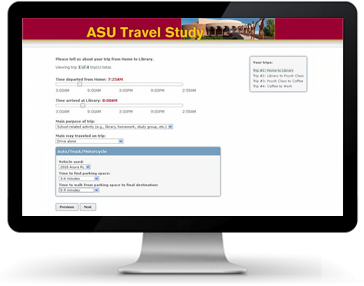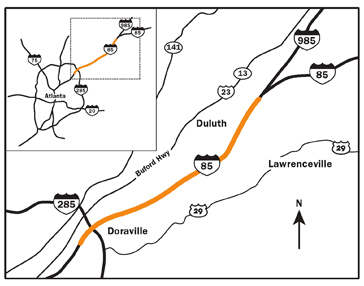Regional Household Travel Survey
As one of the fastest growing areas of Washington (located about 60 miles south of Seattle), the Thurston region has experienced significant growth. In order to provide data to update, refine, and enhance the travel assumptions in the Thurston Regional Planning Council’s travel demand model, RSG is conducting a Household Travel Survey (HTS) for the…
Arizona State University Travel Diary Survey
RSG conducted a one-day travel diary survey in collaboration with Arizona State University (ASU) for the Maricopa Association of Governments (MAG). ASU is one of the largest universities in the United States with 70,000 students located at the main campus in Tempe and three satellite campuses in the Greater Phoenix region. On a similar scale,…
Long Distance Passenger Travel Demand Modeling Framework
RSG led a team of academics (from University of Texas at Austin, Arizona State University, Auburn University, and University of Leeds) to develop a framework for a long distance travel demand model that can be used to build a national model for the U.S. This framework included exploration of advanced modeling methods for existing state-wide…
Quantitative Approaches for Project Prioritization: A Puget Sound Case Study
Transportation projects in major metropolitan regions can vary widely in the types of benefits they provide and in the scales of those benefits. Travel forecasting models and related procedures can provide reasonable estimates of those benefits and many of the benefits can be distilled into equivalent dollar benefits using consumer surplus or other valuation approaches….
Ohio Medium/Small MPO Model Update
The Ohio Medium/Small MPO Model System (OMS) was developed 10 years ago to provide a standard enhanced four step modeling framework for eight of Ohio’s smaller MPO areas. As part of the 2010 model update, a number of improvements are being made to the system. ODOT’s goal is to move their small/medium sized models towards…
HELPViz: Integrated CommunityViz – Land-use Model
RSG designed and implemented a new, two-level approach to land-use forecasting that integrates econometric land-use modeling techniques—implemented in TransCAD—with CommunityViz’s GIS/3D visualization functionality and parcel-level detail. The Evansville region has experienced moderate, steady growth in recent decades but struggled with increasing vacancy in some areas as new development outpaced overall growth. A new regional plan…
Tour-based and Supply Chain Modeling for Freight
Despite recent advances in freight and commercial vehicle modeling, the current state of the practice methods are not adequate to address the increasingly complex issues related to freight demand. This project includes research that has combined tour-based truck models and logistics supply chain models for urban commercial vehicle movements, and that has demonstrated a functional…
Characteristics of Premium Transit Services That Affect Mode Choice
The purpose of this research for the Transportation Research Board (TRB) was to describe the most important factors that differentiate premium transit services from standard transit services and to quantify, for practical use, the magnitude of these distinguishing features. The research team’s goals were to improve the transit industry’s understanding of mode choice determinants, and…
Model Improvement Program – Freight Forecasting
RSG developed valley-wide and county-level goods movement model improvements for the eight San Joaquin Valley county agencies as part of the San Joaquin Valley Model Improvement Program (MIP). The goods movement modeling improvements included updating commodity flow data, updating economic flow data, updating agriculture flow data, and revising the methods used for short-haul commercial vehicles…
Utah Statewide Travel Study
RSG designed and implemented a statewide household travel diary study for the six major planning agencies across Utah. The work included a one-day travel diary completed by more than 9,100 households across the state, a panelized long-distance travel household diary, an in-depth attitudinal question survey customized by metropolitan planning organization (MPO)/region, and a detailed bike…
Traveler Behavior Longitudinal Panel
As a complement to the Integrated Corridor Management (ICM) Initiative Demonstration projects that are being funded by U.S. DOT, the Volpe Center and RSG are conducting a 2-year online longitudinal survey panel of automobile and transit peak-period travelers who use the US-75 corridor in Dallas and the I-15 corridor in San Diego. The goal of…
Impact of Road Pricing on Traveler Behavior
RSG conducted a study with the Volpe National Transportation Systems Center (Volpe Center) to measure changes in travel behavior in response to road pricing projects in Seattle and Atlanta. The study purpose was to provide an in-depth understanding of all the dimensions of traveler behavior changes at the individual, household, and segment level (such as…












